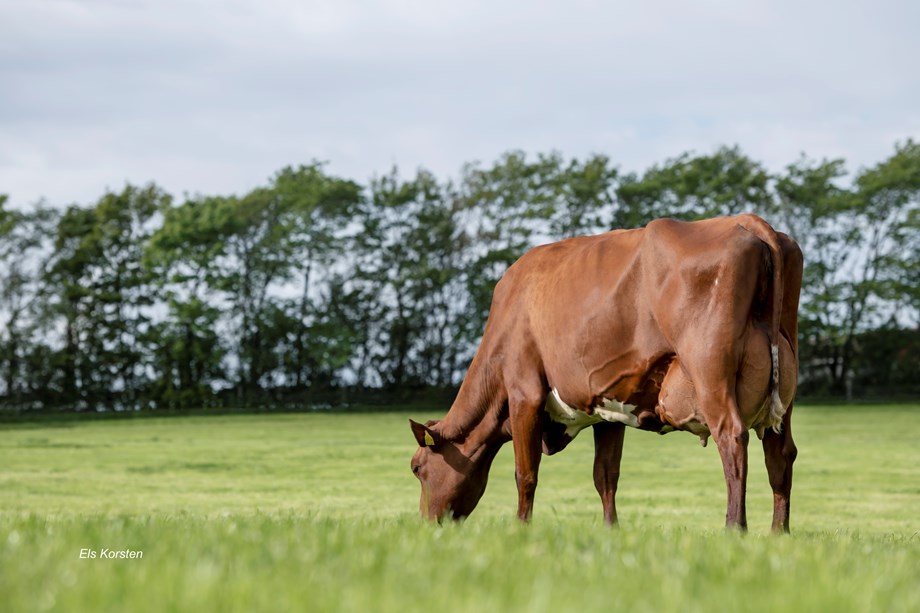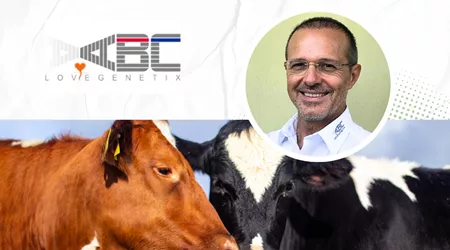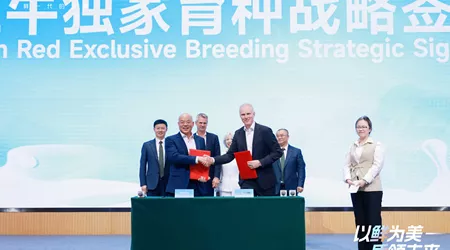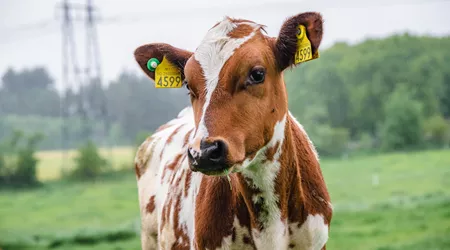By: Håvard M. Tajet & Diego Galli
Norwegian Red has undergone a remarkable surge in genetic enhancement in recent years, attributed to the strategic decisions implemented in our breeding program. In 2022, we recorded the fastest genetic progress ever accomplished within our breed, and we expect the trend to continue. In simpler terms, Norwegian Red Genetics is now yielding superior cows at an unprecedented pace. This groundbreaking development brings excellent news for dairy farmers, not only in Norway but also on the global stage.
The unique factors driving this rapid acceleration are diverse, and the following chart provides insights to facilitate a deeper understanding:
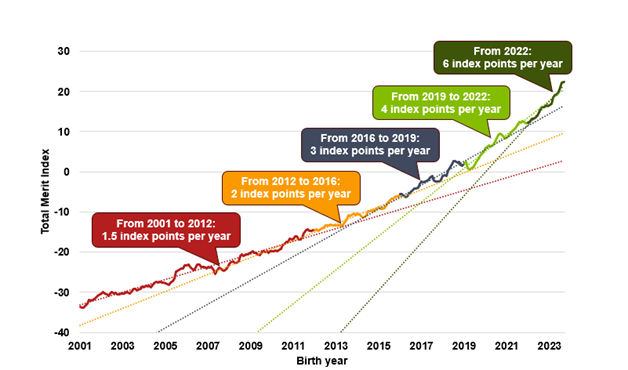
Genetic progress (expressed as Total Merit Index) for the Norwegian Red female population. One standard deviation is 12 index points
- 2001 to 2012: The period of progeny-tested bulls
- 2012 to 2016: Introduction of genomic selection for pre-selecting bulls
- 2016 to 2019: Complete transition to genomic selection in 2016, with all bulls in our breeding program being 100% GS. Dairy farmers across Norway adopted 100% GS sires, phasing out the daughter-proven bulls
- 2019 to 2022: Technological advancements in genomic selection, commencing with our embryo project focused on recruiting elite heifers for embryo production. A significant increase in the number of genotyped animals within the Norwegian Red population
- From 2022: Further refinement of GS technology, accompanied by a fast acceleration in the number of genotyped animals. To date, around 220,000 animals boast genotyped information. This significant accomplishment, coupled with our extensive repository of phenotypic information, firmly positions place ourselves in a very strong position.
And how does the concept of "accelerated genetic enhancement in Norwegian Red" translate for dairy farmers?
The dairy farmers we engage with understand the science of genomic selection and recognize the importance of achieving genetic progress in the breed for competitiveness. However, their primary concern revolves around the question, "What are the practical benefits for me? How does this genetic progress manifest in my everyday reality? Do positive trends on charts translate into tangible improvements in my cows' actual performance?"
Our answer is affirmative! Norwegian Red cows indeed exhibit enhanced performance compared to the past. Norwegian Red cows now produce higher quantities of milk solids, showcase improved fertility and better udders. This goes beyond showing theoretical graphs and trends; when considering all the traits, we see a positive correlation between genomic information and the actual phenotypes and performances of Norwegian Red cows.
For example, Norwegian Red cows in 2022 produced on average 170 kg of milk solids (fat & protein Kg) per cow/lactation more than they did in 2000.
This is due both to improved milk yields per cow (approx. 30% increase) and improved fat & protein percentages (respectively approx. 3% and 10%) in the period.
Data Snapshot: Improved Fertility and Health Traits in Norwegian Red Cows
Norwegian Red cows have consistently demonstrated exceptional fertility, and this is evident as we affirm and validate Norwegian Red as the leading genetics for dairy cattle fertility.
From 2000 to 2020, we have enhanced the already high fertility standards in Norway. Norwegian Red heifers in 2022 recorded a 77% NRR 56d (Non-Return Rate at 56 days after insemination) while Norwegian Red cows recorded 71% NRR 56d. When using a different KPI for fertility, Norwegian Red cows in 2022 had an average calving interval of 372 days. It’s important to note that only 1.6% of Norwegian Red cows are synchronized, meaning the excellent fertility of NR cows has been largely due to genetics and not due to management and it didn’t happen at a significant cost for dairy farmers.
Specifically on the health traits and performances, Norwegian Red cows in 2022 documented the following information:
• Cows not treated for mastitis: 87.8%
• Cows not treated for ketosis: 98.9%
• Cows not treated for milk fever: 96.1 %
These are phenomenal results.
Better udder conformation
There is a strong positive development for the udder conformation trait in the Norwegian Red breed. But does this improvement translate when assessing individual cows?
To determine the existence of a positive correlation between genomics and phenotypes, we have carried out an analysis of all scored animals from 2015 until today. The analysis consists of data from nearly 117,000 Norwegian Red cows. We have corrected for assessment year and month, lactation number, number of hours since milking, and number of times cows were milked/day. Based on this analysis, we have looked at the development in relation to the year of birth of the cow.
Positive development on rear udder attachment and udder depth:
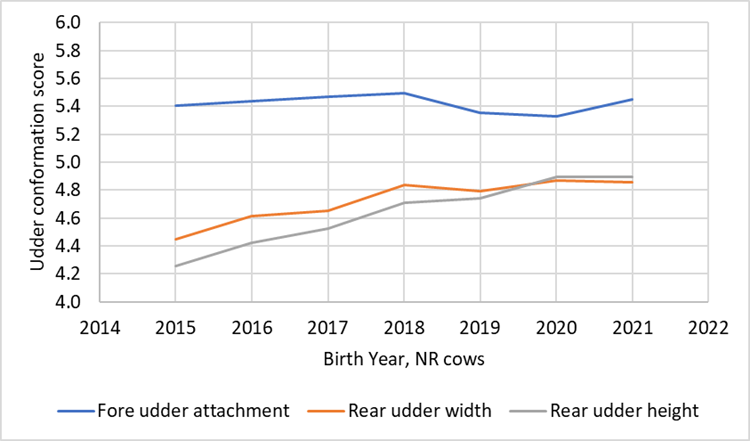
Phenotypic development (udders’ score at evaluation) for udders from the year of birth 2015 until 2021
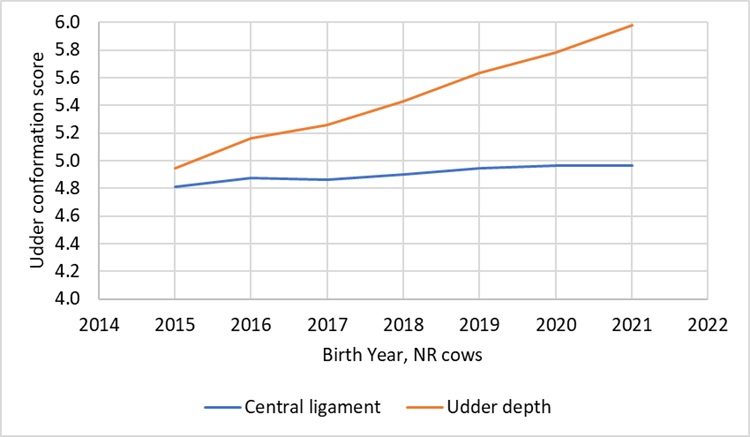
Phenotypic development in (udders’ score at evaluation) for central ligament, udder depth, and udder balance from the year of birth 2015 until 2021
Progress for important traits in udder conformation associated with longevity
Udder attachment and udder depth are the important udder sub-indexes associated with longevity, and we are seeing good progress here. Based on recent changes we made in our breeding program, we expect that progress for udder attachment, and especially for fore udder attachment will increase, while progress for udder depth will moderate somewhat.
For udder balance and central ligament, we have maintained the level. In summary, we can say that we are making good progress for many important traits in the udder conformation. The udder of Norwegian Red cows born in 2021 is significantly better than those born in 2015. With the high focus we have on udder conformation in the breeding program, we expect that we will accelerate even further.
61% of cows in Norway are milked in AMS (automatic milking system). 40% of the herds in Norway have AMS installed. 63% of the milk produced in Norway is from cows in AMS
It's time for dairy farmers worldwide to gain benefits from Norwegian Red genetics
“Bravery without foresight is like a blind horse,” - Persian proverb.
In the 1970s, Geno's choice to initiate breeding for cows' fertility and health traits was undoubtedly a courageous and forward-thinking decision. Typically, genetic selection requires considerable time before yielding results, a fact accentuated in the case of low heritability traits such as fertility and health. Norwegian dairy farmers understood the necessity for patience, placing their confidence in Geno's strategy. Their trust was well-founded, ultimately leading to significant rewards.
Most - if not - all major dairy cattle genetics in the 1970s (and for many decades afterward) were mainly focused on breeding for milk production and conformation, and Norwegian Red has been able over the past 50 years to maintain its competitive advantage in fertility and health traits as we have described above. Plus, achieving increased milk production and improved udders conformation.
Modern purebred Norwegian Red cows have the genetic potential to deliver impressive performances in terms of milk yields and %, fertility, health traits, and functional conformation. This is what we see when looking both at genetic progress and phenotypic results (“real life”).
The performances are even better when Norwegian Red genetics is used in a well-designed crossbreeding strategy. The progress will be even faster, for generation after generation.
We’ve never met a dairy farmer who is willing to wait years before getting a better herd of cows. That's precisely why global dairy farmers should now leverage crossbreeding with Norwegian Red genetics—they'll see substantial and faster returns compared to breeding with purebred cows.
